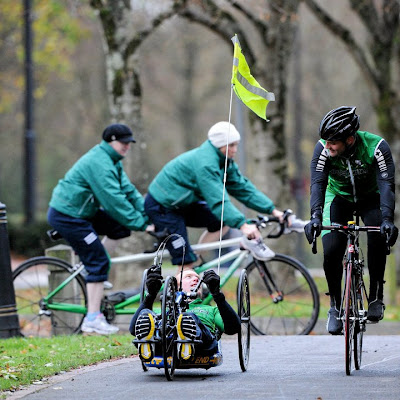I am confronted by it all the time – the inevitable comments of "you're such an inspiration" when people hear of my quest to ride in the Paralympics. That because I have a disability and chose to try and overcome it by doing something relatively simple – something that the majority of people reading this right now do on a daily basis – that somehow that makes me a better person. That I should be looked upon as any more worthy than the next person is laughable though. For I am NOT an inspiration, nor have I ever wanted to be one.
I ride a bike because I enjoy it. And I compete because it motivates me to train when I otherwise wouldn't. Competition is one of those yardsticks that you use to measure your progress from month to month and year to year. Beating people that were better than me the year before, or riding a time trial faster than the week before brings with it a sense of personal accomplishment and gives me the motivation I need to keep going, and keep pushing to ride at the highest level. But if you think I do it for any altruistic purpose or to any way inspire other people with a disability (or even the less fit able-bodied athletes out there), you would be sorely mistaken.
I just finished watching a documentary about someone that every single Canadian will know; a young man by the name of Terry Fox. When Terry was 19, he lost his leg to cancer. It was amputated above the knee (quite close the the hip). As I was just 21 years old when I lost my leg, I can relate to his situation in some respects. But that is where the similarities end.
 |
| Terry Fox in 1980 |
In 1980, at the age of 22, Terry decided to embark on one of the most incredible journeys any Canadian has ever made. It is this endeavour that has imprinted his name indelibly upon the consciousness of all Canadians, and indeed many people around the world. Terry decided that he was going to run across Canada to raise money for Cancer research.
In 1980 there was no internet, no 24 hour a day news channels, no satellite TV and artificial leg technology was in the dark ages compared to what it is today. To say that this was a massive undertaking by any standard, let alone modern ones, is something of an understatement. Furthermore, if you know anything about the size of Canada, you'll appreciate how difficult something like this was.
Calling it "the Marathon of Hope", his goal was to try and raise $1 for every one of the 24 million people living in Canada at the time. When the run started in April of 1980, virtually no one had ever even heard of Terry Fox. It was just him and his best friend driving along behind in a camper van. But as the days passed and more and more people began to hear of this extraordinary feat, he quickly became something of a national celebrity.
Terry Fox ran 3,339 miles in 143 days. That's an average of 23.3 miles a day.... for a 143 days in a row. And while that may not seem that hard, consider this: Terry had his leg amputated slightly below the hip. So he wasn't running all those miles as you might – he did it in such a way that it was almost a 'hop'.
Tragically, his journey was cut short and he never made it all the way across the country. The cancer that had claimed his leg returned and spread to his lungs. Terry died 9 months later.
To this day, annual fundraising runs are held in his honor all across Canada - and the Terry Fox Foundation has raised over $500 million dollars (£330 million). He is a TRUE inspiration to so many people – not only for what he attempted, but because that is what he WANTED to do. He wanted to show cancer patients that life can go on, that the disease doesn't have to rule your life. He chose to put himself forward as something to aspire to – and is still considered a national hero by most Canadians. And while he isn't the reason behind why I do what I do, it certainly gives me pause to think when I consider what he achieved and how that pales in comparison to riding a bike for a few hours a day.






















